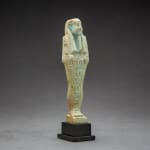26th Dynasty Faience Ushabti, 664 BCE - 525 BCE
Faience
10.8 x 3.8 cm
4 1/4 x 1 1/2 in
4 1/4 x 1 1/2 in
X.0344
Further images
The 26th Dynasty, also known as the Saite Period, is traditionally placed by scholars at the end of the Third Intermediate Period or at the beginning of the Late Dynastic...
The 26th Dynasty, also known as the Saite Period, is traditionally placed by scholars at the end of the Third Intermediate Period or at the beginning of the Late Dynastic Period. In either case, the Saite Period rose from the ashes of a decentralized Egyptian state that had been ravaged by foreign occupation. Supported by the assistance of a powerful family centered in the Delta town of Sais, the Assyrians finally drove the Nubians out of Egypt. At the close of this campaign, Ashurbanipal’s kingdom was at the height of its power; however, due to civil strife back east, he was forced to withdraw his forces from Egypt. Psamtik I, a member of the family from Sais, seized this opportunity to assert his authority over the entire Nile Valley and found his own dynasty, the 26th of Egyptian history. Known as the Saite Period due to the importance of the capital city Sais, the 26th Dynasty, like many before it, sought to emulate the artistic styles of past pharaohs in order to bolster their own claims to power and legitimize their authority.
Faience, which dates back to predynastic times, at least 5,000 years, is a glasslike non-clay substance made of materials common to Egypt: ground quartz, crushed quartz pebbles, flint, a soluble salt-like baking soda, lime and ground copper, which provided the characteristic color. The dried objects went into kilns looking pale and colorless but emerged a sparkling "Egyptian blue." Called tjehnet by the Ancient Egyptians, meaning that which is brilliant or scintillating, faience was thought to be filled with the undying light of the sun, moon and stars and was symbolic of rebirth. Ancient Egyptians believed the small blue-green objects helped prepare them for eternity in the afterlife.
Perhaps no single object epitomizes the spirit of Ancient Egypt better than the ushabti. Shaped like a divine mummy, the ushabti evokes the magical side of the Egyptian belief in an afterlife, while the pick and hoes clutched in the hands, as well as the seed bag slung over his shoulder, recall the rural, agrarian culture of the land. The word ushabti (supplanting the older term shawabti) literally means “the answerer.” The function of these little figures is described in Chapter 6 of the Book of the Dead: “O this Ushabti! If (the deceased) is called upon to do hard labor in the hereafter, say thou: I am here.” The ushabti was expected to answer the call to work in place of the deceased, and this passage was frequently inscribed on the figures themselves. Originally, a single ushabti was placed in a given tomb; but by the New Kingdom, the statues had come to be regarded as servants and slaves for the deceased rather than as a substitute, and many might be found buried together, along with an overseer figure. In the course of Egyptian history, ushabti were created from wood, stone, metal, and faience. In the cultural renaissance of the 26th Dynasty, a green faience, the color of the Nile and evocative of the verdant landscape in springtime, was particularly popular. Along the body of this ushabti, a vertical column of hieroglyphic inscription has been inscribed. Such inscriptions generally offer prayers from the deceased and reveal the ushabti’s readiness to perform labor. To look upon this ushabti is to come face to face with the mystery and magic of Egypt itself.
Faience, which dates back to predynastic times, at least 5,000 years, is a glasslike non-clay substance made of materials common to Egypt: ground quartz, crushed quartz pebbles, flint, a soluble salt-like baking soda, lime and ground copper, which provided the characteristic color. The dried objects went into kilns looking pale and colorless but emerged a sparkling "Egyptian blue." Called tjehnet by the Ancient Egyptians, meaning that which is brilliant or scintillating, faience was thought to be filled with the undying light of the sun, moon and stars and was symbolic of rebirth. Ancient Egyptians believed the small blue-green objects helped prepare them for eternity in the afterlife.
Perhaps no single object epitomizes the spirit of Ancient Egypt better than the ushabti. Shaped like a divine mummy, the ushabti evokes the magical side of the Egyptian belief in an afterlife, while the pick and hoes clutched in the hands, as well as the seed bag slung over his shoulder, recall the rural, agrarian culture of the land. The word ushabti (supplanting the older term shawabti) literally means “the answerer.” The function of these little figures is described in Chapter 6 of the Book of the Dead: “O this Ushabti! If (the deceased) is called upon to do hard labor in the hereafter, say thou: I am here.” The ushabti was expected to answer the call to work in place of the deceased, and this passage was frequently inscribed on the figures themselves. Originally, a single ushabti was placed in a given tomb; but by the New Kingdom, the statues had come to be regarded as servants and slaves for the deceased rather than as a substitute, and many might be found buried together, along with an overseer figure. In the course of Egyptian history, ushabti were created from wood, stone, metal, and faience. In the cultural renaissance of the 26th Dynasty, a green faience, the color of the Nile and evocative of the verdant landscape in springtime, was particularly popular. Along the body of this ushabti, a vertical column of hieroglyphic inscription has been inscribed. Such inscriptions generally offer prayers from the deceased and reveal the ushabti’s readiness to perform labor. To look upon this ushabti is to come face to face with the mystery and magic of Egypt itself.









